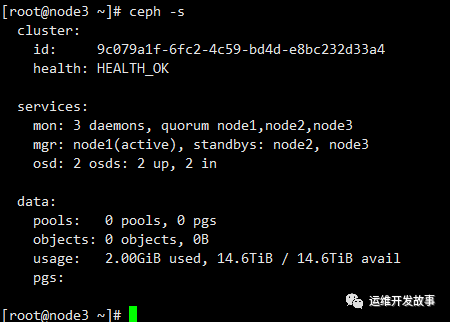
关于中兴新支点系统
中兴新支点操作系统基于Linux稳定内核,分为嵌入式操作系统(NewStart CGEL)、服务器操作系统(NewStart CGSL)、桌面操作系统(NewStart NSDL),经过近10年专业研发团队的积累和发展,产品形成安全加固、自主可控、易用管理的突出优势。目前,中兴新支点操作系统已在国内外各大电信运营商、国有大中型企业及电子政务解决方案中投入使用,服务于交换网络、核心网络、骨干网络、智慧城市、视频监控等系统底层。以上转自某乎。
背景
在国家数字化转型和国产化替代的大背景下,尤其是政务类项目,现在基本用国产化的CPU和操作系统来承载其业务,实现自主创新和安全可靠。本文在中兴新支点系统(CGSL)和海光CPU上进行ceph离线部署。下面方法也适用于龙蜥和centos8。
制作离线安装包
首先需要找一台可以联网的中兴新支点机器,在上面制作ceph的离线rpm源。中兴新支点系统会默认安装一些组件(如libvirt、qemu),为避免安装ceph时与其他包产生依赖冲突问题,安装系统的时候可以选择最小安装。项目中其他需要安装的组件后面一起安装。我这边除了ceph,libvirt的包也会用到,系统默认安装libvirt的版本较低,我这里都采用手动方式部署并制作离线的rpm包。
yum源配置
中兴新支点系统目前没发现有官方的在线yum源地址。在线安装可以使用龙蜥和epel8的yum源。下面是yum源的配置。
配置yum缓存:
安装ceph
制作离线仓库
安装ceph
使用做的离线rpm包安装ceph。
部署monitor节点
所有 Ceph 群集至少需要一个monitor,并且至少需要与存储在群集上的对象副本一样多的 OSD。引导初始mon是部署 Ceph 存储群集的第一步,这里我直接在node1、node2、node3创建三个mon。
在node1添加monitor
为集群生成唯一的fsid,fsid是群集的唯一标识符,代表 Ceph 存储群集主要用于 Ceph 文件系统的文件系统 ID。
创建ceph配置文件,将生成的fsid添加到配置文件中。
为群集创建keyring并生成monitor keyring。monitor通过密钥相互通信。必须生成具有monitor密钥的keyring,并在引导初始monitor时提供keyring。
生成管理员keyring,生成用户并将用户添加到client.admin keyring中。要使用 CLI 工具,必须有一个用户,并且还必须将用户添加到monitor keyring。
生成引导 osd 密钥,生成用户并将用户添加到client.bootstrap-osd keyring中。
将生成的键添加到 ceph.mon.keyring。
更改 ceph.mon.keyring的所有者。
使用主机名、主机 IP 地址和 FSID 生成monitor映射。将其保存为 :/tmp/monmap。
在monitor主机上创建默认数据目录,目录名是{cluster-name}-{hostname}格式。
在node1节点对monitor进行初始化。
启动mon。
在另外两个节点安装mon
将密钥和配置文件拷贝至其他节点。
在两个节点上修改ceph.mon.keyring属主和属组为ceph。
获取monmap信息。
在mon节点上进行mon初始化。
在两个节点上启动mon。
修改ceph.conf并重启ceph-mon(所有节点操作)。
移除mon
添加osd
Ceph提供了该ceph-volume实用程序,该实用程序可以准备逻辑卷,磁盘或分区以供Ceph使用。该ceph-volume实用程序通过增加索引来创建OSD ID。
创建osd
在node1执行。
上面的创建过程可以分为两个阶段(准备和激活):
启动各个节点osd进程。
创建MGR
在运行ceph-mon守护程序的每个节点上,还应该设置一个ceph-mgr守护程序。
创建密钥目录
所有mgr节点都要执行。
创建身份验证密钥
启动mgr守护进程
最后查看ceph运行状态,我只添加了两个osd。


































